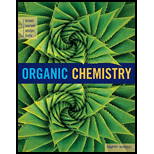
Concept explainers
Interpretation:
It should be explained that the ascorbic acid
Concept introduction:
Acid - ionization constant
Acids ionize in water. Strong acids ionize completely whereas weak acids ionize to some limited extent.
The degree to which a weak acid ionizes depends on the concentration of the acid and the equilibrium constant for the ionization.
The ionization of a weak acid
The equilibrium expression for the above reaction is given below.
Where,
Smaller value of
Equilibrium in all acid – base reactions favours formation of the weaker base or weaker acid.
Want to see the full answer?
Check out a sample textbook solution
Chapter 17 Solutions
Organic Chemistry
- he partnership of Winn, Xie, Yang, and Zed has the following balance sheet: Cash $ 35,000 Liabilities $ 47,000 Other assets 241,000 Winn, capital (50% of profits and losses) 65,000 Xie, capital (30%) 84,000 Yang, capital (10%) 45,000 35,000 Zed, capital (10%) Zed is personally insolvent, and one of his creditors is considering suing the partnership for the $4,000 that is currently owed. The creditor realizes that this litigation could result in partnership liquidation and does not wish to force such an extreme action unless Zed is reasonably sure of obtaining at least $4,000 from the liquidation. Determine the amount for which the partnership must sell the other assets to ensure that Zed receives $4,000 from the liquidation. Liquidation expenses are expected to be $20,000. (Do not round intermediate calculations.) Minimum Amount:arrow_forwardNonearrow_forwardDon't use ai to answer I will report you answerarrow_forward
- Identify the type of inorganic solids with complex structure that each of the following are:a) LiNiO2b) CaTiO3c) Fe3O4arrow_forwardThe mass percent of carbon in pure glucose, C6H1206, is 40.0 percent. A chemist analyzes an impure sample of glucose and determines that the mass percent of carbon is 38.2 percent. Which of the following impurities could account for the low mass percent of carbon in the sample? Water, H₂O Ribose, C5H1005 Fructose, C6H1206, an isomer of glucose Sucrose, C12H22O11 columns and 4 £arrow_forwardSubstitution Reactions Predicting the product of a nucleophilic substitution reaction Draw the organic product you would expect to isolate from the nucleophilic substitution reaction between the molecules shown. Note: You do not need to draw any of the side products of the reaction, only the substitution product. HO + + Br xx X S C Click and drag to start drawing a structure.arrow_forward
- Indicate the structure of MgIIAlIII2O4:a) spinel.b) ilmenite.c) NaCl superstructure.d) montmorillonite.arrow_forwardWhat is the major product or products in each of the following transformations.Clearly show the stereochemistry where appropriate with the use of wedged or dashed lines. also predict namearrow_forwardDesign a multistep synthetic route that coverts the starting material to the product. Show all necessary reagents and the (stable) intermediates from each step. You DO NOT need to show mechanisms. CIarrow_forward
- Calculate the equilibrium constant for the reaction NiO(s) + H2 = Ni(s) + H₂O at 750 °C from the following data: 1 Ni(s) + - O₂ = NiO(s) AGº = −244,555 + 98.53T Joules 1 H₂+-02 2 = H₂O AG° = -246,438 + 54.81T Joules Could pure solid nickel be annealed at 750 °C in an atmosphere containing 95 % H2O and 5 % H2 by volume, without oxidation? (6+6)arrow_forwardPlease correct answer and don't use hand ratingarrow_forwardBased upon this “business as usual” projection, approximately how many Gt of CO2 would be added to the atmosphere by 2100 relative to today? (Current mixing ratio of CO2 is 424 ppmv, mass of the atmosphere is 5.15´1021 g).arrow_forward
 Chemistry: Principles and ReactionsChemistryISBN:9781305079373Author:William L. Masterton, Cecile N. HurleyPublisher:Cengage Learning
Chemistry: Principles and ReactionsChemistryISBN:9781305079373Author:William L. Masterton, Cecile N. HurleyPublisher:Cengage Learning Introduction to General, Organic and BiochemistryChemistryISBN:9781285869759Author:Frederick A. Bettelheim, William H. Brown, Mary K. Campbell, Shawn O. Farrell, Omar TorresPublisher:Cengage Learning
Introduction to General, Organic and BiochemistryChemistryISBN:9781285869759Author:Frederick A. Bettelheim, William H. Brown, Mary K. Campbell, Shawn O. Farrell, Omar TorresPublisher:Cengage Learning Introductory Chemistry: A FoundationChemistryISBN:9781337399425Author:Steven S. Zumdahl, Donald J. DeCostePublisher:Cengage Learning
Introductory Chemistry: A FoundationChemistryISBN:9781337399425Author:Steven S. Zumdahl, Donald J. DeCostePublisher:Cengage Learning


